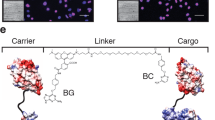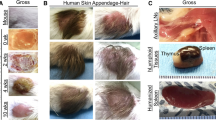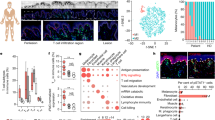Abstract
A major issue in long-term gene therapy is host immune responses to therapeutic cells when transgene encodes a potential antigen. The nature of these responses depends on several factors including the type of cell and tissue expressing the transgene. Keratinocytes and fibroblasts, which are known to display distinct immunogenic profiles, are both potential targets for transgene expression in cutaneous gene therapy. However, whether there is an immunological advantage in targeting one cell type over the other is not known. To study the effect of cell type on transgene-specific host responses independent of antigen levels or methods of gene transfer and transplantation, we used a skin transplantation model in which transgene expression can be targeted transgene to either keratinocytes or fibroblasts. Although targeting an antigen to either cell type resulted in the induction of immune responses, these responses differed significantly. Transgenic keratinocytes were rejected acutely by a dominant Th2 response, while in the majority of grafted animals transgenic fibroblasts failed to induce acute rejection despite the induction of Th1 type inflammation in the graft. In a small number of mice, transgenic fibroblasts persisted for at least 20 weeks despite elicitation of antigen-specific responses. Therefore, fibroblasts may be an immunologically preferred target over keratinocytes for cutaneous gene therapy.
This is a preview of subscription content, access via your institution
Access options
Subscribe to this journal
Receive 12 print issues and online access
$259.00 per year
only $21.58 per issue
Buy this article
- Purchase on Springer Link
- Instant access to full article PDF
Prices may be subject to local taxes which are calculated during checkout





Similar content being viewed by others
References
Uitto J, Pulkkinen L . The genodermatoses: candidate diseases for gene therapy. Hum Gene Ther 2000; 11: 2267–2275.
Hengge UR . Gene therapy progress and prospects: the skin--easily accessible, but still far away. Gene Therapy 2006; 13: 1555–1563.
Mingozzi FH, Katherine A . Immune responses to AAV in clinical trials. Curr Gene Ther 2007; 7: 316–324.
Le Guiner C, Stieger K, Snyder RO, Rolling F, Moullier P . Immune responses to gene product of inducible promoters. Curr Gene Ther 2007; 7: 334–346.
Mavilio F, Pellegrini G, Ferrari S, Di Nunzio F, Di Iorio E, Recchia A et al. Correction of junctional epidermolysis bullosa by transplantation of genetically modified epidermal stem cells. Nat Med 2006; 12: 1397–1402.
Bessis N, GarciaCozar FJ, Boissier MC . Immune responses to gene therapy vectors: influence on vector function and effector mechanisms. Gene Therapy 2004; 11: S10–S17.
Brown BD, Lillicrap D . Dangerous liaisons: the role of ‘danger’ signals in the immune response to gene therapy. Blood 2002; 100: 1133–1140.
Ghazizadeh S, Kalish RS, Taichman LB . Immune-mediated loss of transgene expression in skin: implications for cutaneous gene therapy. Mol Ther 2003; 7: 296–303.
Lu Z, Ghazizadeh S . Host immune responses in ex vivo approaches to cutaneous gene therapy targeted to keratinocytes. Exp Dermatol 2005; 14: 727–735.
Lu Z, Ghazizadeh S . Loss of transgene following ex vivo gene transfer is associated with a dominant Th2 response: implications for cutaneous gene therapy. Mol Ther 2007; 15: 954–961.
Kupper TS, Fuhlbrigge RC . Immune surveillance in the skin: mechanism and clinical consequences. Nat Rev Immunol 2004; 4: 211–222.
Goto M, Sawamura D, Ito K, Abe M, Nishie W, Sakai K et al. Fibroblasts show more potential as target cells than keratinocytes in COL7A1 gene therapy of dystrophic epidermolysis bullosa. J Invest Dermatol 2006; 126: 766–772.
Lerner-Tung MB, Hull BE . The role of allogeneic epidermis in murine graft rejection. J Burn Care Rehabil 1989; 10: 151–155.
Morimoto N, Saso Y, Tomihata K, Taira T, Takahashi Y, Ohta M et al. Viability and function of autologous and allogeneic fibroblasts seeded in dermal substitutes after implantation. J Surg Res 2005; 125: 56–67.
Otto WR, Nanchahal J, Lu QL, Boddy N, Dover R . Survival of allogeneic cells in cultured organotypic skin grafts. Plast Reconstr Surg 1995; 96: 166–176.
Sher SE, Hull BE, Rosen S, Church D, Friedman L, Bell E . Acceptance of allogeneic fibroblasts in skin equivalent transplants. Transplantation 1983; 36: 552–557.
Hultman CS, Brinson GM, Siltharm S, deSerres S, Cairns BA, Peterson HD et al. Allogeneic fibroblasts used to grow cultured epidermal autografts persist in vivo and sensitize the graft recipient for accelerated second-set rejection. J Trauma 1996; 41: 51–58.
Smith TJ . Insights into the role of fibroblasts in human autoimmune diseases. Clinical Exp Immunol 2005; 141: 388–397.
Haniffa MA, Wang XN, Holtick U, Rae M, Isaacs JD, Dickinson AM et al. Adult human fibroblasts are potent immunoregulatory cells and functionally equivalent to mesenchymal stem cells. J Immunol 2007; 179: 1595–1604.
Hebda PA, Dohar JE . Transplanted fetal fibroblasts: survival and distribution over time in normal adult dermis compared with autogenic, allogenic, and xenogenic adult fibroblasts. Otolaryngol Head Neck Surg 1999; 121: 245–251.
Palmer TD, Rosman GL, Osborne WR, Miller AD . Genetically modified skin fibroblasts persist long after transplantation but gradually inactivate introduced genes. Proc Natl Acad Sci USA 1991; 88: 1330–1334.
Chen L, Nelson DM, Zheng Z, Morgan RA . Ex vivo fibroblast transduction in rabbits results in long-term (>600 days) factor IX expression in a small percentage of animals. Hum Gene Ther 1998; 9: 2341–2351.
Falanga V, Margolis D, Alvarez O, Auletta M, Maggiacomo F, Altman M et al. Rapid healing of venous ulcers and lack of clinical rejection with an allogeneic cultured human skin equivalent. Human Skin Equivalent Investigators Group. Arch Dermatol 1998; 134: 293–300.
St D, Verma IM . An alternative approach to somatic cell gene therapy. Proc Natl Acad Sci USA 1988; 84: 3150–3154.
Hadjantonakis AK, Gertsenstein M, Ikawa M, Okabe M, Nagy A . Generating green fluorescent mice by germline transmission of green fluorescent ES cells. Mech Dev 1998; 76: 79–90.
Oliva Jr AA, Jiang M, Lam T, Smith KL, Swann JW . Novel hippocampal interneuronal subtypes identified using transgenic mice that express green fluorescent protein in GABAergic interneurons. J Neurosci 2000; 20: 3354–3368.
Li MO, Wan YY, Sanjabi S, Robertson AK, Flavell RA . Transforming growth factor-beta regulation of immune responses. Annu Rev Immunol 2006; 24: 99–146.
Ito M, Ogawa K, Takeuchi K, Nakada A, Heishi M, Suto H et al. Gene expression of enzymes for tryptophan degradation pathway is upregulated in the skin lesions of patients with atopic dermatitis or psoriasis. J Dermatol Sci 2004; 36: 157–164.
Agnello D, Lankford CS, Bream J, Morinobu A, Gadina M, O'Shea JJ et al. Cytokines and transcription factors that regulate T helper cell differentiation: new players and new insights. J Clin Immunol 2003; 23: 147–161.
Morel PA, Falkner D, Plowey J, Larregina AT, Falo Jr LD . DNA immunisation: altering the cellular localisation of expressed protein and the immunisation route allows manipulation of the immune response. Vaccine 2004; 22: 447–456.
Boyle JS, Koniaras C, Lew AM . Influence of cellular location of expressed antigen on the efficacy of DNA vaccination: cytotoxic T lymphocyte and antibody responses are suboptimal when antigen is cytoplasmic after intramuscular DNA immunization. Int Immunol 1997; 9: 1897–1906.
Condon C, Watkins SC, Celluzzi CM, Thompson K, Falo Jr LD . DNA-based immunization by in vivo transfection of dendritic cells. Nat Med 1996; 2: 1122–1128.
Heath WR, Belz GT, Behrens GM, Smith CM, Forehan SP, Parish IA et al. Cross-presentation, dendritic cell subsets, and the generation of immunity to cellular antigens. Immunol Rev 2004; 199: 9–26.
Larrengina AT, Falo Jr LD . Changing paradigms in cutaneous immunology: adapting with dendritic cells. J Invest Dermatol 2005; 124: 1–12.
Guermonprez P, Valladeau J, Zitvogel L, Thery C, Amigorena S . Antigen presentation and T cell stimulation by dendritic cells. Annu Rev Immunol 2002; 20: 621–667.
Iwasaki A . Division of labor by dendritic cells. Cell 2007; 128: 435–436.
Liu Y-J, Soumelis V, Watanabe N, Ito T, Wang Y-H, de Waal Malefyt R et al. TSLP: An epithelial cell cytokine that regulates T cell differentiation by conditioning dendritic cell maturation. Annu Rev Immunol 2007; 25: 193–219.
Liu YJ . Thymic stromal lymphopoietin: master switch for allergic inflammation. J Exp Med 2006; 203: 269–273.
Yoo J, Omori M, Gyarmati D, Zhou B, Aye T, Brewer A et al. Spontaneous atopic dermatitis in mice expressing an inducible thymic stromal lymphopoietin transgene specifically in the skin 4. J Exp Med 2005; 202: 541–549.
Rocha PN, Plumb TJ, Crowley SD, Coffman TM . Effector mechanisms in transplant rejection. Immunol Rev 2003; 196: 51–64.
Meijerink J, Mandigers C, van de Locht L, Tonnissen E, Goodsaid F, Raemaekers J . A novel method to compensate for different amplification efficiencies between patient DNA samples in quantitative real-time PCR. J Mol Diagn 2001; 3: 55–61.
Acknowledgements
This research was supported by Grant R01-AR050525 from the National Institute of Health to SG.
Author information
Authors and Affiliations
Corresponding author
Additional information
Supplementary Information accompanies the paper on Gene Therapy website (http://www.nature.com/gt)
Supplementary information
Rights and permissions
About this article
Cite this article
Zhang, Z., Kuscu, C. & Ghazizadeh, S. Transgene-specific host responses in cutaneous gene therapy: the role of cells expressing the transgene. Gene Ther 16, 1138–1145 (2009). https://doi.org/10.1038/gt.2009.67
Received:
Revised:
Accepted:
Published:
Issue Date:
DOI: https://doi.org/10.1038/gt.2009.67
Keywords
This article is cited by
-
Options for tracking GFP-Labeled transplanted myoblasts using in vivofluorescence imaging: implications for tracking stem cell fate
BMC Biotechnology (2014)
-
Distinct Strategies Are Required to Suppress Antigen-specific Responses to Genetically Modified Keratinocytes and Fibroblasts
Molecular Therapy (2012)
-
Transcutaneous Gene Gun Delivery of hNC16A Induces BPAG2-Specific Tolerance
Journal of Investigative Dermatology (2012)



